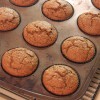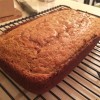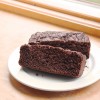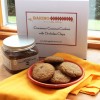I’m hardly an expert, and experienced bakers won’t get much out of this, but beginners like myself might find some of these baking tips useful. Here, in no particular order, are some helpful hints for new bakers:
EGGS
Crack your eggs on a flat surface instead of an edge, you’re less likely to create shards of shell that can fall into your batter. If you do drop in a piece of eggshell, the best way to get it out is using another, larger piece of eggshell.
If you run out of eggs, and you have flax seed, you can make flax eggs! I tablespoon ground flax with three tablespoons water = 1 egg. Beat VERY well to get it to a gooey, eggy texture. I realize not everybody has flax around, but if you do, it’ll save the day.
EASY SUBSTITUTES
Yogurt and sour cream are usually interchangeable in recipes. It won’t always work out perfectly; sometimes it’s about the flavor as well as the texture, but generally, you can swap one out for the other as needed.
You can also swap out yogurt for applesauce, as long as it’s not there to create an apple-y flavor.
For yogurt, I prefer to use a low fat vanilla, but plain is fine too, fat free, full fat, whatever you like.
When a recipe calls for all purpose flour, you can often use whole wheat white instead. I don’t do it in things that are supposed to be very light, like lemon cakes, but it works really well in just about any other cookie, quick bread, muffin, etc.
If you want to eat healthier, for every cup of flour, swap out 1/3 of it for wheat germ, which is incredibly good for you and if anything makes baked goods a little fluffier.
LOWERING THE FAT CONTENT
I don’t like to use fake butter, but I do like to swap out butter & oil for yogurt. I know a lot of people like to use applesauce, but I feel like it affects the texture too much and makes things too moist. It’s more effective and less intrusive in small amounts.
For butter: use half the butter in the recipe, and then put in half of the half as much yogurt. Make sense? If the recipe calls for half a cup of butter, put in a quarter cup of butter and then an eighth of a cup of yogurt.
For oil: use half the oil in the recipe, and then 3/4 of what’s left should be butter. This one is trickier to measure as you have to get into tablespoons. So half a cup of oil becomes a quarter cup of oil and about 6 tablespoons of yogurt.
Other things you can do are to swap out regular sour cream, yogurt, cream cheese, and buttermilk for the light versions. Don’t go to zero fat, but a low fat version will get you the same results.
SUGAR
In most cases, you can automatically reduce the amount of sugar a recipe calls for without noticing any difference whatsoever. Start with baby steps, if it says a cup, try just under that. A lot of bakers tell me they can reduce by 1/3 and sometimes 1/2 and everything still turns out sweet and delicious. Some of that depends on your sweet tooth, so experiment.
You can also play with different types of sugar. I almost never use white sugar anymore. Try brown sugar in muffins for a different flavor, try pure cane sugar in just about anything. I’ve been playing with coconut palm sugar lately. There are a lot of options.
TOOTHPICKS
Toothpicks are your friend. You use them to test your baked goods to see if they’re done, I’m sure. You can also use them to pry muffins out of pans. They’re especially well-suited to mini muffins.
MEASURING FLOUR

You probably know this already, but the best way to measure flour (short of weighing it, of course) is to scoop the flour lightly into a measuring cup, being careful NOT to pack it, and then level it off with a knife. Do not reach the cup into the flour and scoop that way. (Of course, if an expert baker is making something with you, and he or she scoops, just be quiet. Chances are they’ve been doing this for years and know what they’re doing. When I made scones with Barb at Mussers’ B&B, I just watched, listened, and learned.)
WHEAT GERM
Wheat germ is my new obsession. I’ve been using it in a lot of my muffins, loaves, and cookies as of late. For every cup of flour, substitute 1/3 of it with wheat germ. (Don’t forget to refrigerate the wheat germ after opening it!) So far I haven’t had anything turn out one iota less fluffy or delicious.
DON’T OVERMIX!
The easiest way to ruin a batch of muffins is to overmix the batter. Muffins can be the easiest thing to whip together, but if you overmix the batter, they turn out tough and unpleasant.
SPICES
Look at the amount of spices in a recipe as a recommendation rather than a hard and fast rule. I always use more cinnamon, usually more nutmeg, and more ginger too. I tend to be more careful when it comes to cloves or cardamom, which can easily become overpowering, but anything else can be seasoned to your own taste.
Spices also taste better when they’re freshly ground. If you have the motivation, get a little nutmeg grater, grate your cinnamon, and use fresh ginger when it’s convenient. (It isn’t always.)
And add spices that aren’t in the recipe whenever you want! If it’s an oatmeal muffin or cookie, you can add all kinds of great spices to warm it up. I’ve even added pumpkin pie spice (or the spices that go into it) to really random baked goods that didn’t call for it.
BANANA MASHING

I don’t know why I didn’t figure this out earlier, but use a potato masher for bananas. I think it’s just that most recipes say to mash the banana with a fork, but that can be tedious so go for the masher. It’s much more efficient and a lot more satisfying.
ASSEMBLE YOUR INGREDIENTS

My system when I bake is to get all the ingredients out first; it’s all about mise en place. This is a good way to make sure you have everything you need and won’t realize mid-recipe that you’re missing something essential. Then I put back things as I use them, or at least group them together to return them in batches. By the time I’m mixing the dry ingredients into the batter, the baking soda, baking powder, salt, and flour have all gone back to their home in the cupboard. It makes cleaning up go a lot faster.
BAKING TIMES
I took a pastry class once, and the chef teaching it gave me a very valuable piece of advice, which is not to trust the baking times in recipes. It varies tremendously from one oven to another, from one geographical location to another, so set your timer for a lot earlier than the recipe says and keep checking. I’ve had things bake in 35 minutes that said to bake for an hour, and I’ve had to bake others for half an hour longer than the recipe suggested. Don’t trust a stranger who has never been in your kitchen to know the specifics of your oven.
BAKING MUFFINS
My friend Marcie taught me this trick, and it’s a good one: one way to get those nice tops on your muffins is to pre-heat the oven 25 degrees higher than the recipe says. Bake the muffins for five minutes at that temperature, then reduce by that same 25 degrees. This might result in shorter baking times, so keep an eye on them and test early.
LET THE FLAVOR SETTLE
Certain types of baked goods taste better the next day. Broadly, things made with pumpkin settle a bit and really bloom the day after baking. The flavor gets richer and the texture improves; muffins that stick to the paper will come off perfectly the next morning.
GOOGLE EVERYTHING
I use my iPad while I’m baking instead of paper recipes, and it comes in extra handy when I’m trying to figure out a measurement conversion, a last-minute substitute, or try a new process. The first time I made meringue cookies and had to whip the egg whites to stiff peaks, I opened a new tab and quickly found a video demonstrating what they should look like. Same thing for scraping a vanilla bean, or melting chocolate on the stove. The internet is full of helpful conversions, instructions, and videos to help you in your baking adventures.
ASK YOUR EXPERTS
If anyone in your life bakes, ask them questions! Better yet, bake with them. All long time bakers have great tricks to share, and some of them go against conventional wisdom and work beautifully.
READ REVIEWS (AND WRITE THEM, TOO)
One of the reasons I love the internet as a recipe source is the reviews and comments people add after they’ve tried making something. You’ll see variations worth trying, get advice about things that don’t work from the original, find advice about additions, or perhaps discover that this one isn’t something you should make after all. There is a wealth of information at the bottom of the page. If you use the recipe and make changes, post the information for the next person. And if you make something delicious, post that too, so the person who created the recipe knows it’s a hit.








Speak Your Mind